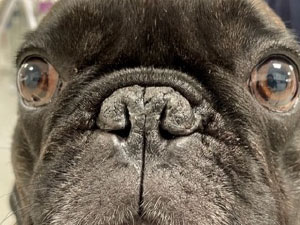Brachycephalic Obstructive Airway Syndrome
‘Brachycephalic’ means ‘short headed’.
The French bulldog, British bulldog, Pug, Pekingese, shih tzu, Japanese chin, boxer and Boston terrier are all examples of brachycephalic breeds. The most distinctive feature of these breeds is their short muzzle.
In recent decades, breeding selection for extreme brachycephalic features has resulted in dogs that are predisposed to upper airway tract obstruction and subsequent respiratory distress, among several other health issues. Although not all brachycephalic dogs show clinical signs, the incidence and severity of the respiratory disorders has increased. The respiratory disease related to brachycephalic confirmation is called brachycephalic obstructive airway syndrome (BOAS). Recent research has shown that the condition occurs in 40% British bulldogs, 45% in French bulldogs and 60% of Pugs.
In brachycephalic dogs, while the length of the skeletal muzzle is reduced, there is often no corresponding decrease in the size of the soft tissue contained in the skull. This results in a constricted effect within the nasal cavity and partial obstruction of the pharynx and larynx.

BOAS is the result of multiple factors acting together to cause obstruction to air flow into the lungs.
Primary factors (present from a very young age and related to the head shape):
- Stenotic nares (narrow nostrils)
- Aberrant nasal turbinates
- Overcrowded turbinates
- Elongated, thick, soft palate
- Laryngeal collapse (Pugs only)
Secondary factors (progressive deteriorations to the airway resulting from the abnormal forces present during breathing):
- Mucosal hypertrophy
- Laryngeal collapse
- Tonsillar hypertrophy / eversion
- Gastro-intestinal signs (regurgitation, acid reflux, vomiting, hypersalivation)

The signs of BOAS are varied and can range in severity, including some or all of the following:
- Respiratory noise:
- Snorting or snoring at rest of during exercise
- Reduced or poor exercise tolerance
- Difficulty breathing either at rest of during exercise
- Prolonged recovery after exercise
- Stenosis of the nostrils
- Gastrointestinal signs
- Retching, regurgitation, and vomiting
- Obstructive sleep apnoea / sleep-disordered breathing
- Heat intolerance
- Cyanosis (discoloured/purple gum colour) and Collapse (due to lack of air).
You should consider seeking veterinary advice if you have noticed any of the clinical signs outlined above.
